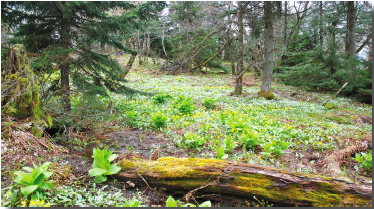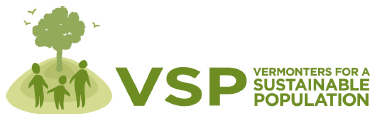Adopt a New Definition of Sustainable or Sustainability!
Sustainable
Primarily out of concern about the environment, the Executive Committee of the Vermont Chapter of the Sierra Club on April 11, 2014 adopted the following definition of the adjective:
Sustainable means that the people living in a given politically or geographically defined area do not live beyond the limits of the renewable resources of that area for either input (energy and matter) or output (food, material goods, and absorption of pollution). They purchase or trade from environmentally conscious sources for those necessities that cannot be locally satisfied. They live both in numbers and in a manner that allows present and future generations of all life in that area to enjoy a healthy habitat over the long term.
Sustainability
Primarily out of compassion for all living things, the Vermont Chapter of the Buddhist Peace Fellowship on June 12, 2014, adopted the following definition of the noun:
Populations in a given politically or geographically defined area become truly
sustainable…
• when living within the limits of that area's renewable resources, both in inputs (energy and materials) and outputs (food, goods, etc., and the area's capacity to absorb damage and regenerate).
• when such populations purchase or trade only with environmentally responsible sources, for those necessities unavailable locally.
• when population density and manner of living support the health and well-being of all species and habitats, for the present generation, and all those to come.

The same, or a very similar definition, has also been adopted by the following organizations, businesses, and institutions:
Vermonters for Sustainable Population, October 2013
Green Energy Times, April 2014
There are three reasons why this definition is stronger and much more meaningful than any other definition. The first is that when using the term it has to be applied to a given political area and not just used as if the resources of the world are at hand. The second is that the resources used both to meet all human needs and to absorb the pollution generated needs to come from renewable resources. Finally, when we apply the term sustainable it should apply to all life native to that region and not just Homo Sapiens.
If your organization, business, or institution uses the term “sustainable” or “sustainability” in its mission, program, or services, please urge your governing body to adopt one of these definitions or a similar definition, so that it is clear to the public what you mean when you use it, so that we will develop a true public understanding of the importance of making changes needed to achieve true sustainability. If it does clarify the meaning, please have your name added to this list by contacting George Plumb at plumb.george "at" gmail.com, a member of the two organizations above and the executive director of Vermonters for Sustainable Population.
[The above statement was issued June 16, 2014.]
Background and rigorous study
“We abuse land because we regard it as a commodity belonging to us. When we see land as a community to which we belong, we may begin to use it with love and respect.” ~ Aldo LeopoldIn 1973, the Vermont Natural Resources Council, in what may be the first environmental report ever published in Vermont -- the Vermont Population Policy Report -- stated that, ”We must determine Vermont’s carrying capacity, then we must estimate the number of people that can live here so that every Vermonter has access to a life of quality that he can afford.”
A recent, thorough investigation of what "sustainable" must mean -- according to 16 indicators (scientific disciplines and areas of study) -- has been done by an array of experts for Vermonters for Sustainable Population. It is in the form of a 65-page publication titled What Is An Optimum Sustainable Population for Vermont?, at vspop.org, created principally by Heather V. Davis, published May 2014.
Each indicator's section concludes with a statement like this one for the Environmental Health section: "For a healthy environment a truly sustainable population size for Vermont is approximately 400,000." (The number provided varies for each section, but not exceedingly so in either direction.)
The document was well reviewed by the presidents of the Center for the Advancement of the Steady State Economy, the Population Institute, and the Population Media Center. The project was essentially personally ratified by venerable organizations' heads, including that of the Center for Biological Diversity, a national U.S. group using science, law and creative media to protect the lands, waters and climate that species need to survive.
Culture Change will be listed as one of the endorsers of the June, 2014 definition document. Will your organization join us? Would you wish to see a similar investigative study on sustainability and population-size for each of the other 49 states and the District of Columbia?

* * * * *
For any questions, comments, or suggestions regarding the report What Is An Optimum Sustainable Population for Vermont?, please contact George Plumb at plumb.george "at" gmail.com
Previous Culture Change articles on population size, population growth and overpopulation include:
The Population Bomb - revisited by What Is Sustainable, 21 Nov 2014 by Richard Adrian Reese
What Is Worse, An Older Population Or Running Out Of Resources?, 17 Jun 2014 by Simon Ross, Population Matters
Done with Math, 27 Dec 2012 by Albert Bates
Population Is Popping - Why We Cover Our Ears and Eyes, 23 Apr 2012 by Jan Lundberg
Population growth must be addressed with insight, 20 Mar 2009 by Michael Poremba and Jan Lundberg
Population, Nature, and What Women Want, 11 Sep 2008 by John Wertime, reviewing Robert Engelman's book More: Population, Nature, and What Women Want
Overpopulation & terrorism: rats in a cage, Culture Change Magazine, by John Omaha, late fall 2001

